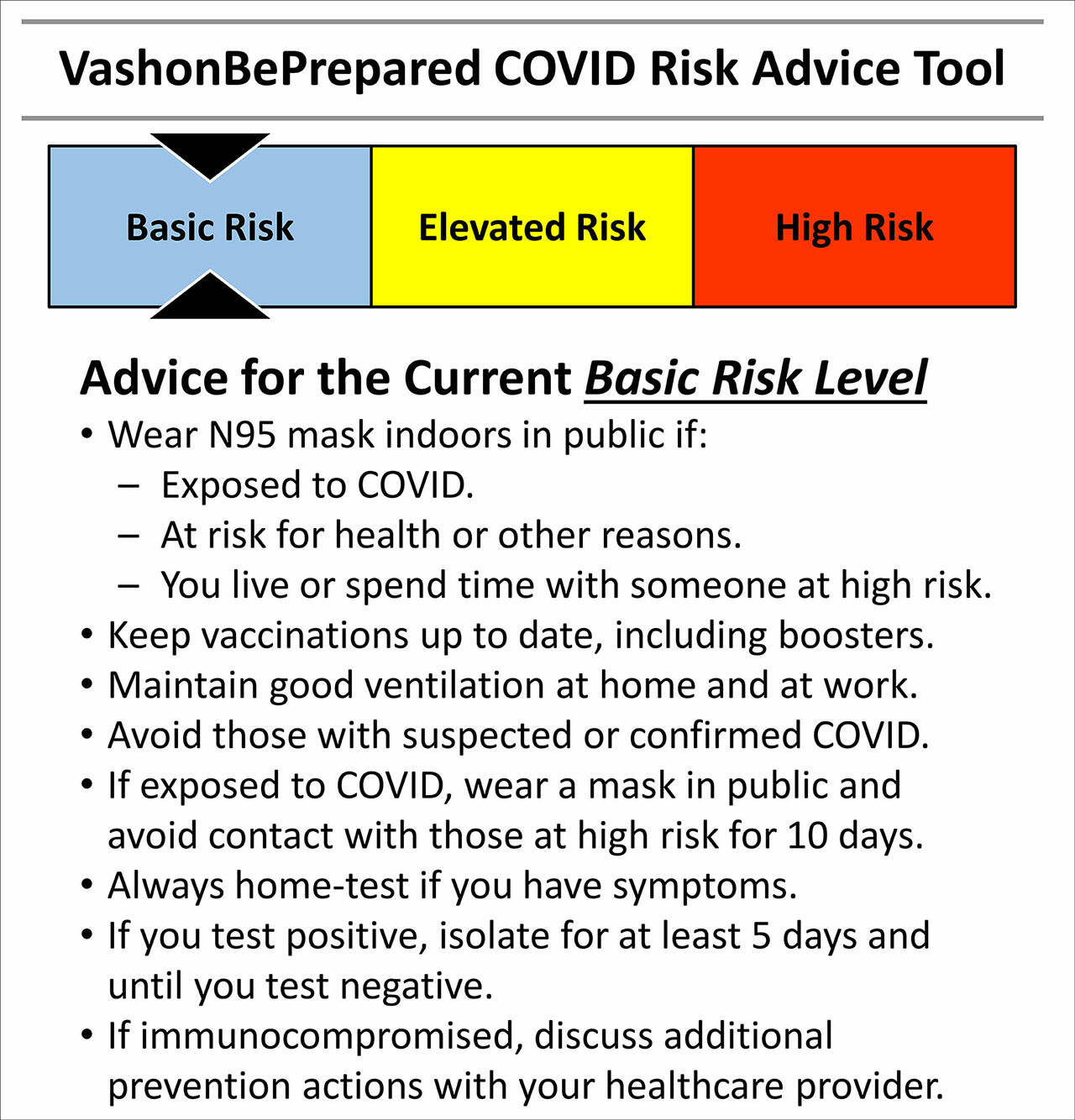Some people have been saying to VashonBePrepared: “Could you just tell me if I should wear a mask or not? Isn’t the number of cases pretty useless now that everybody is testing at home? The raw statistics are nice, but we need advice about what the data means and what we should do about it.”
In response, we have developed a new Vashon-specific risk-assessment tool.
In upcoming community newsletters and reports in The Beachcomber, we’ll provide you with this easy-to-understand current risk-level rating customized for Vashon.
And, we’ll provide simple, plain-language advice for actions you can choose to take to reduce your chances of getting and spreading COVID. We’ll still periodically publish infographics and other visual tools you are used to seeing on these pages, as needed to help explain why risk levels are moving up or down.
The new tool recognizes that Vashon Island exists in a three-county COVID exposure pool — King, Kitsap, and Pierce.
Every day about one-third of the island’s population takes a mainland round-trip ferry ride and is potentially exposed in one of the three mainland counties. That’s why the tool is based on population-weighted data for the three-county area provided by the Washington State Department of Health dashboard.
The agility of this new tool will help us give you advice, as circumstances change, so you have information that will help you deal with rising or receding risk. For example, although the tool shows Basic Risk Level now, the tri-county hospitalization rate is fluttering on the edge between Basic Risk and Elevated Risk, and trends for case rate and positivity rate are mixed. We are closely monitoring the situation.
The new tool grew out of a VashonBePrepared/Medical Reserve Corps pilot project with Vashon Island Fire & Rescue (VIFR), which utilized a similar three-level tri-county approach with COVID prevention measures calibrated to each risk category.
The three-level concept has been in use for some months to guide VIFR personnel on the use of masking and other preventive measures. Elements have also been borrowed from the CDC and Public Health – Seattle & King County (PHSKC) dashboards for community risk.
The Risk-Assessment Metrics
Basic Risk = Less than 3.5 hospitalizations/week/100K people. Public health trends factored in, including case rate and positivity rate, which are monitored to assess the potential for increased risk.
Elevated Risk = 3.5 through 7.0 hospitalizations/week/100K people. Public health trends factored in, including case rate and positivity rate, indicating a COVID wave may be on the way (moving up from Basic Risk) or receding (coming down from High Risk).
High Risk = More than 7.0 hospitalizations/week/100K people. Case rate, positivity rate, and other public health trends rising sharply or already at a high level. COVID spike is in progress.
Situation Update: Looking Ahead to Fall and Winter
A consensus is growing among public health experts: A new COVID wave appears to be building up in Western Europe with hospitalizations rising in many countries. As recently covered in this newspaper and community updates, there has been a surge every year so far during the pandemic.
The surges follow a familiar pattern. First, cases rise in Europe. Then numbers start trending up on the east coast of the U.S. Quickly, the COVID wave washes across the country and reaches the Pacific Northwest. Some public health experts are now predicting our regional winter COVID wave could begin in mid-November.
Why would this potential wave be happening? So far, no new COVID variant has taken hold to dominate infections, although that could change. Several factors may be giving the COVID virus an advantage.
• People are tired of the pandemic and are dropping their guard, including their masks.
• Immunity from having COVID and from vaccination has waned, reducing protection against getting infected, and increasing chances of serious disease and long COVID.
• Political leadership has been eager to declare an end to the pandemic, despite the ongoing high daily death level in the U.S. As a result, uptake of the Omicron-targeted booster has been low, especially in the vulnerable 50- to 64-year-old age group.
Timing Your Omicron-Targeted Booster
If you’ve been waiting to make a decision, now is the perfect time to get your Omicron-targeted booster vaccine. As explained above, a potential new COVID wave may be coming. If there’s a new COVID wave, it will be good to have extra Omicron-specific protection against severe disease.
Risk is rising in crowds as people no longer wear their masks because they perceive that the pandemic is over. Your immunity may have waned and a vaccine top-up could mean the difference between a few sick days or having to go to the hospital, or even suffering long COVID. It’s a sweet spot of timing. And, it’s easy to get the new booster. The Omicron-targeted booster is widely available at pharmacies and healthcare providers on the mainland, as well as the island’s Sea Mar clinic.
Although the weekend adult high-capacity vaccination clinics have ended, appointment slots are still available at Vashon Pharmacy. Sign up for an appointment at VashonPharmacy.com/COVID-Vaccine.
There’s a checkbox during signup to get your seasonal flu vaccine at the same time.
Omicron-Targeted Boosters Approved for Younger Kids
Federal and state authorizations are complete for the Omicron-targeted booster for elementary school kids. Everyone who is five years old and above is now eligible for an Omicron booster vaccine.



